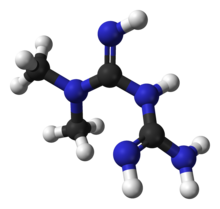Template:Good article is only for Wikipedia:Good articles.
 | |
 | |
| Clinical data | |
|---|---|
| Pronunciation | /mɛtˈfɔːrmɪn/, met-FOR-min |
| Trade names | Fortamet, Glucophage, Glumetza, others |
| Other names | N,N-dimethylbiguanide[1] |
| AHFS/Drugs.com | Monograph |
| MedlinePlus | a696005 |
| License data | |
| Pregnancy category |
|
| Routes of administration | By mouth |
| Drug class | Biguanide[3] |
| Legal status | |
| Legal status | |
| Pharmacokinetic data | |
| Bioavailability | 50–60%[4][5] |
| Protein binding | Minimal[4] |
| Metabolism | Not by liver[4] |
| Elimination half-life | 4–8.7 hours[4] |
| Excretion | Urine (90%)[4] |
| Identifiers | |
| |
| Chemical and physical data | |
| Formula | C4H11N5 |
| Molar mass | 129.167 g·mol−1 |
| 3D model (JSmol) | |
| Density | 1.3±0.1[6] g/cm3 |
| |
| |
Metformin, marketed under the trade name Glucophage among others, is the first-line medication for the treatment of type 2 diabetes,[3][9] particularly in people who are overweight.[10] It is also used in the treatment of polycystic ovary syndrome.[3] It is not associated with weight gain.[11] It is taken by mouth.[3]
Metformin is generally well tolerated.[12] Common side effects include diarrhea, nausea, and abdominal pain.[3] It has a low risk of causing low blood sugar.[3] High blood lactic acid level is a concern if the medication is used in overly large doses or prescribed in persons with severe kidney problems.[13][14] It is not recommended in those with significant liver disease.[3] While no clear harm comes from use during pregnancy, insulin is generally preferred for gestational diabetes.[3][15] Metformin is a biguanide antihyperglycemic agent.[3] It works by decreasing glucose production by the liver and increasing the insulin sensitivity of body tissues.[3]
Metformin was discovered in 1922.[16] French physician Jean Sterne began study in humans in the 1950s.[16] It was introduced as a medication in France in 1957 and the United States in 1995.[3][17] It is on the World Health Organization's List of Essential Medicines.[18] Metformin is the most widely used medication for diabetes taken by mouth.[16] It is available as a generic medication.[3] The wholesale price in the developed world was between US$0.20 and $6 per month as of 2014[update].[19] In the United States, it costs 5 to 25 USD per month.[3] In the UK, a standard 500 mg tablet costs around £0.03, with other forms being more expensive.[20] In 2017, it was the fourth-most commonly prescribed medication in the United States, with more than 78 million prescriptions.[21][22]
References edit
- ^ Sirtori CR, Franceschini G, Galli-Kienle M, Cighetti G, Galli G, Bondioli A, Conti F (December 1978). "Disposition of metformin (N,N-dimethylbiguanide) in man". Clinical Pharmacology and Therapeutics. 24 (6): 683–93. doi:10.1002/cpt1978246683. PMID 710026.
- ^ a b "Metformin Use During Pregnancy". Drugs.com. 10 September 2019. Archived from the original on 16 April 2020. Retrieved 4 February 2020.
- ^ a b c d e f g h i j k l m n "Metformin Hydrochloride". The American Society of Health-System Pharmacists. Archived from the original on 24 December 2016. Retrieved 2 January 2017.
- ^ a b c d e Dunn CJ, Peters DH (May 1995). "Metformin. A review of its pharmacological properties and therapeutic use in non-insulin-dependent diabetes mellitus". Drugs. 49 (5): 721–49. doi:10.2165/00003495-199549050-00007. PMID 7601013.
- ^ Hundal RS, Inzucchi SE (2003). "Metformin: new understandings, new uses". Drugs. 63 (18): 1879–94. doi:10.2165/00003495-200363180-00001. PMID 12930161.
- ^ "metformin_msds". Archived from the original on 12 June 2017. Retrieved 2 August 2020.
- ^ "METFORMIN oral - Essential drugs". medicalguidelines.msf.org. Archived from the original on 29 August 2021. Retrieved 31 August 2020.
- ^ "WHOCC - ATC/DDD Index". www.whocc.no. Archived from the original on 17 September 2020. Retrieved 31 August 2020.
- ^ Maruthur NM, Tseng E, Hutfless S, Wilson LM, Suarez-Cuervo C, Berger Z, Chu Y, Iyoha E, Segal JB, Bolen S (June 2016). "Diabetes Medications as Monotherapy or Metformin-Based Combination Therapy for Type 2 Diabetes: A Systematic Review and Meta-analysis". Annals of Internal Medicine. 164 (11): 740–51. doi:10.7326/M15-2650. PMID 27088241.
- ^ Clinical Obesity (2nd ed.). Oxford: John Wiley & Sons. 2008. p. 262. ISBN 978-0-470-98708-7. Archived from the original on 2017-09-08.
- ^ "Type 2 diabetes and metformin. First choice for monotherapy: weak evidence of efficacy but well-known and acceptable adverse effects". Prescrire International. 23 (154): 269–72. November 2014. PMID 25954799.
- ^ Triggle CR, Ding H (January 2017). "Metformin is not just an antihyperglycaemic drug but also has protective effects on the vascular endothelium". Acta Physiologica. 219 (1): 138–151. doi:10.1111/apha.12644. PMID 26680745.
- ^ Blumenberg A, Benabbas R, Sinert R, Jeng A, Wiener SW (April 2020). "Do Patients Die with or from Metformin-Associated Lactic Acidosis (MALA)? Systematic Review and Meta-analysis of pH and Lactate as Predictors of Mortality in MALA". J Med Toxicol. 16 (2): 222–229. doi:10.1007/s13181-019-00755-6. PMID 31907741.
- ^ Lipska KJ, Bailey CJ, Inzucchi SE (June 2011). "Use of metformin in the setting of mild-to-moderate renal insufficiency". Diabetes Care. 34 (6): 1431–7. doi:10.2337/dc10-2361. PMC 3114336. PMID 21617112.
- ^ Lautatzis ME, Goulis DG, Vrontakis M (November 2013). "Efficacy and safety of metformin during pregnancy in women with gestational diabetes mellitus or polycystic ovary syndrome: a systematic review". Metabolism. 62 (11): 1522–34. doi:10.1016/j.metabol.2013.06.006. PMID 23886298.
- ^ a b c Fischer, Janos (2010). Analogue-based Drug Discovery II. John Wiley & Sons. p. 49. ISBN 978-3-527-63212-1. Archived from the original on 2017-09-08.
- ^ McKee, Mitchell Bebel Stargrove, Jonathan Treasure, Dwight L. (2008). Herb, nutrient, and drug interactions : clinical implications and therapeutic strategies. St. Louis, Mo.: Mosby/Elsevier. p. 217. ISBN 978-0-323-02964-3. Archived from the original on 2017-09-08.
{{cite book}}: CS1 maint: multiple names: authors list (link) - ^ World Health Organization (2019). World Health Organization model list of essential medicines: 21st list 2019. Geneva: World Health Organization. hdl:10665/325771. WHO/MVP/EMP/IAU/2019.06. License: CC BY-NC-SA 3.0 IGO.
- ^ "Metformin". Archived from the original on 3 August 2017. Retrieved 11 January 2016.
- ^ Hitchings, Andrew; Lonsdale, Dagan; Burrage, Daniel; Baker, Emma (2019). The Top 100 Drugs: Clinical Pharmacology and Practical Prescribing (2nd ed.). Elsevier. pp. 154–155. ISBN 978-0-7020-7442-4. Archived from the original on 22 May 2021. Retrieved 9 November 2021.
- ^ "The Top 300 of 2020". ClinCalc. Archived from the original on 12 February 2021. Retrieved 7 April 2020.
- ^ "Metformin Hydrochloride - Drug Usage Statistics". ClinCalc. 23 December 2019. Archived from the original on 19 May 2021. Retrieved 7 April 2020.